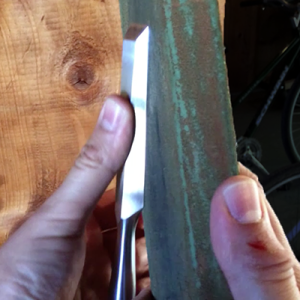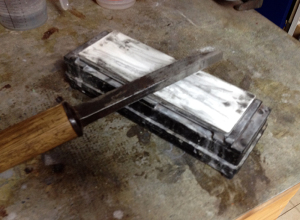Is My Blade Really Sharp?
Yesterday I told you that all your questions could be answered with the simple act of sharpening your blades.
“Sharpening is as simple as rocket science performed in an Afghan cave with shrapnel in your heart”
-Woodworking Forum Curmudgeon (possibly also Iron Man)
So if a sharp blade is the answer to all woodworking’s problems then how does one know they are “doing it right” or it “my iron is truly sharp”?
Simple. Feel the burr, then remove it.
 I don’t care how you sharpen, that’s not what this diatribe is about. Use water stones or sandpaper or shark skin (I hear its best when still on the shark). Use a honing guide or not, I don’t care, it doesn’t matter. All of these are just means to an end: the burr.
I don’t care how you sharpen, that’s not what this diatribe is about. Use water stones or sandpaper or shark skin (I hear its best when still on the shark). Use a honing guide or not, I don’t care, it doesn’t matter. All of these are just means to an end: the burr.
This burr is not mysterious and if you aren’t sure if you feel it, then its not there. Its obvious, your fingers will catch on it, you will know its there. If you don’t feel it you have more work to do. If it doesn’t run across the entire blade, you have more work to do.
When you do feel it, remove it by flipping the blade over. Use the ruler trick if you want or not, just remove the burr til you don’t feel it. Sometimes, depending on the grit of your abrasive medium, you will want check the bevel again and see if you just folded the burr back to the bevel side. If so, remove it. Now you are sharp. Your two geometric planes intersect at a Euclidean G spot. That is sharp. So unless you feel the burr, indicating that you have worked the steel all the way to the edge and remove it you are not sharp.
Now for the Sticky Bit
 Grit doesn’t matter. Abrasive medium doesn’t matter. Any grit will pull up a burr and remove it and therefore any grit will get you sharp.
Grit doesn’t matter. Abrasive medium doesn’t matter. Any grit will pull up a burr and remove it and therefore any grit will get you sharp.
But…
Durability of the edge should be a concern and lower, more abrasive grits will make a more ragged edge and by extension a more ragged burr. When you remove that burr you have a sharp edge but instead of a unified block of sharp steel slicing into the wood you have many little bits of steel much like a microscopic toothing plane. These ragged sharp bits won’t last very long because they don’t have the cohesive strength of their brothers. Imagine a ragged line of Gaul Pikemen under the command of Lothar of the Hill People facing up to a unified Roman Legion with shields interlocked and spears braced, moving as one under the command of Julius Caesar.
If you can’t be the Caesar of your own woodshop then what’s the point?!
As you get finer and finer grits, the scratches that divide the ragged bits get shallower and shallower bringing those bits closer together and backing them up with strong, unified steel. As you make those scratches smaller the light reflects off the surface more predictably until you get that fabled “mirror polish”. Now your 8000 grit honed blade stays sharp longer. Is it really any sharper than the 300 grit belt sanded blade? Probably not but it will last more than a few minutes because the edge is just stronger.
Keep in mind there is a path of diminishing returns here. I know woodworkers who swear by 30,000 grit stones claiming that the edge is truly sharper and lasts much longer. That may be, but I’m not patient enough to do that and I stop at 8000 grit in my own shop. I’ve worked successfully off a 1000 grit oil stone too. It doesn’t matter as long at you feel that burr then remove it.
If you get nothing else from this, don’t be afraid to sharpen. Assume that any difficulties you may be having are due to a dulling blade and sharpen it. When you boil it down to feel the burr and remove it you might be surprised just how quickly an edge can be returned to problem solving status.


